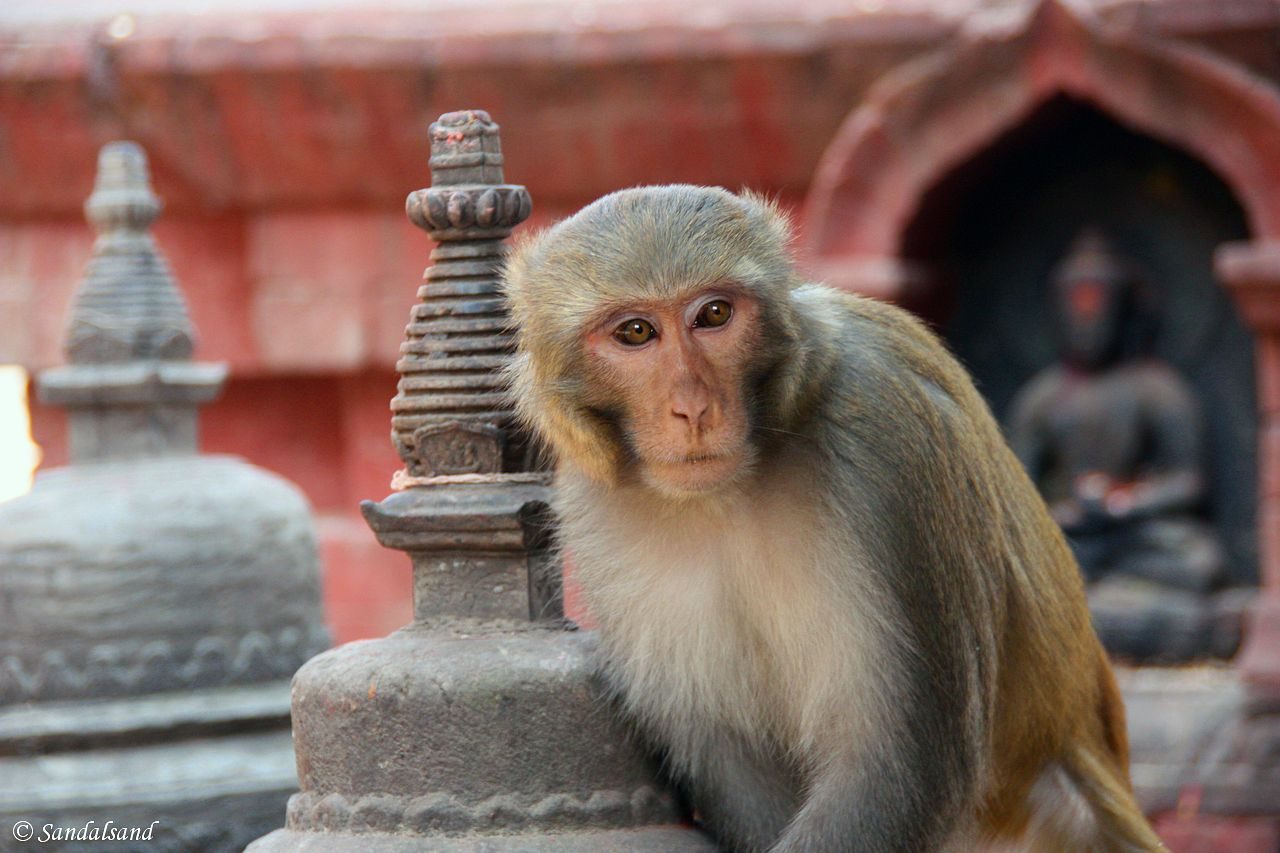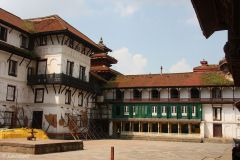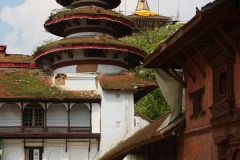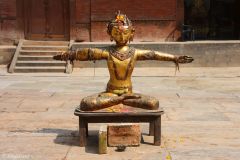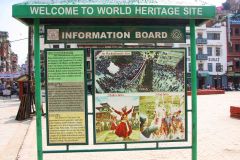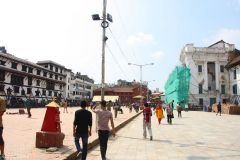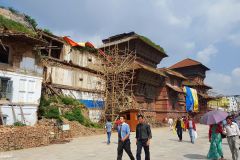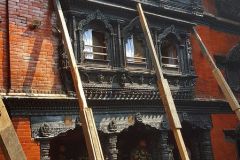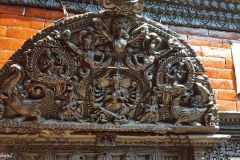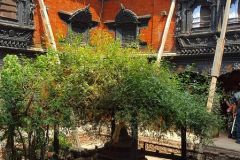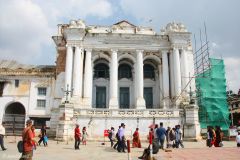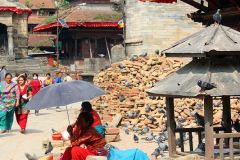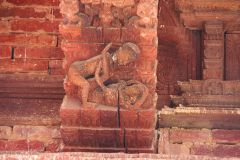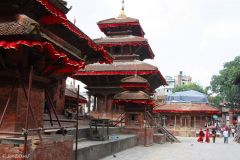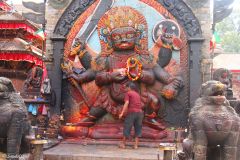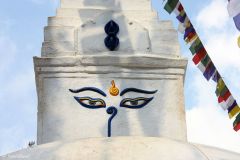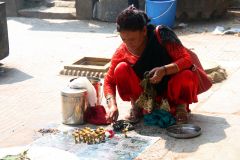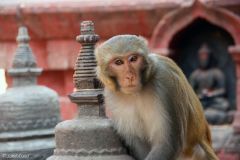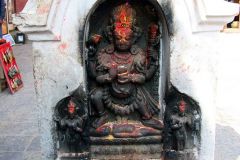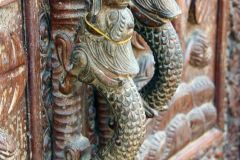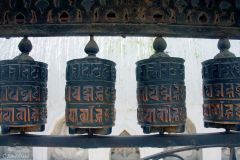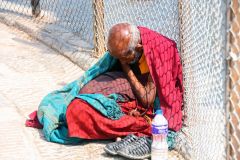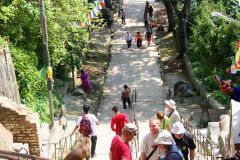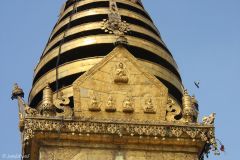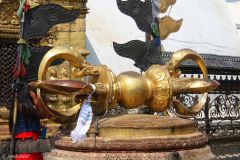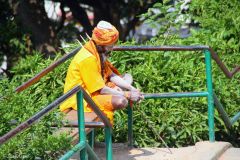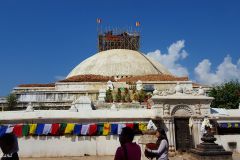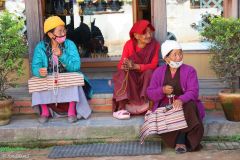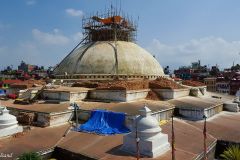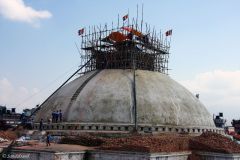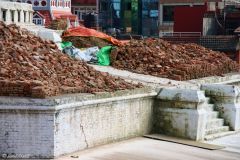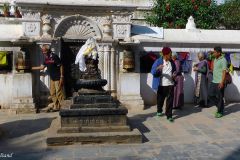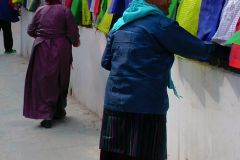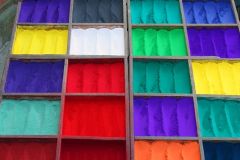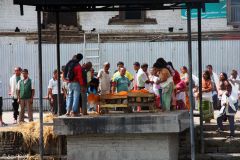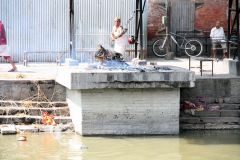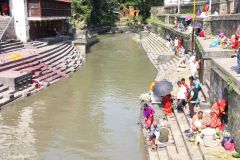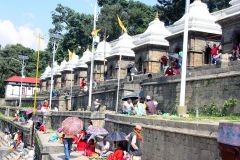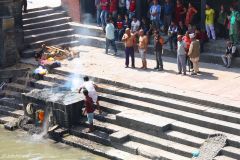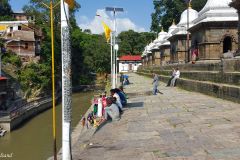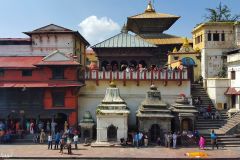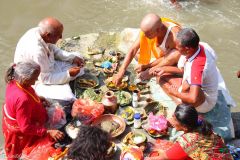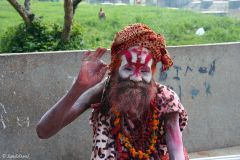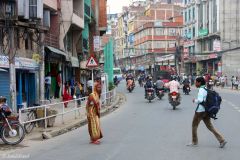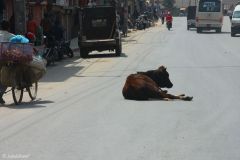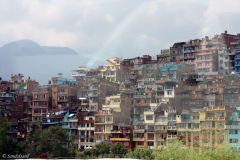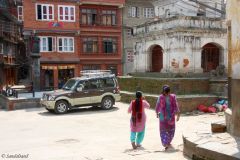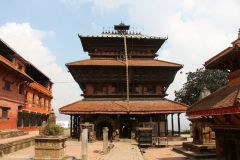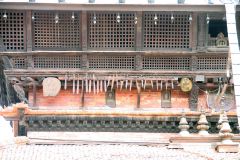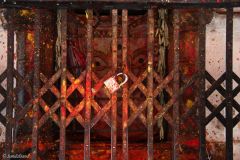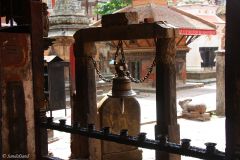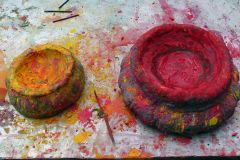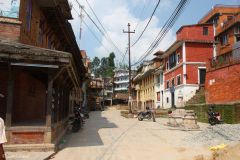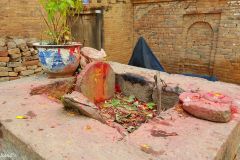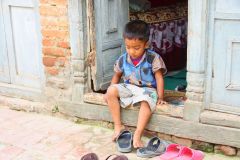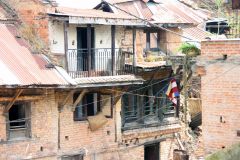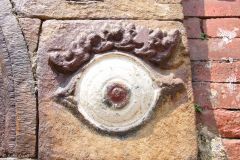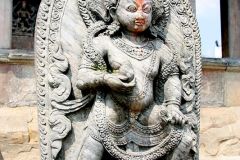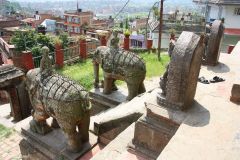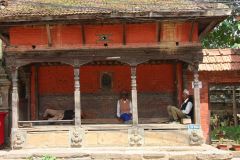Here you get to know Kathmandu’s historic districts and temples. The ancient centre of Kathmandu has several important temples and also the old royal palace where kings used to be crowned. Durbar simply means palace, and the palace squares in Kathmandu, Patan og Bakhtapur are all World Heritage Sites. We will be visiting the last two in the next articles, and concentrate on Kathmandu here.
Durbar Square
The Royal Palace
The Royal Palace or Hanuman Dhoka had suffered damages in the April 2015 earthquake and several courtyards inside the large structure had been closed to visitors. We managed to get inside the most important one, named Nasal Chowk. It was a wonderful courtyard, and it was here that the latest coronation in Nepal took place, in 2001.
Basantapur tower
Leaving the palace and entering the first of the three interconnected squares of Durbar Square a look back revealed that the top of the Basantapur tower had collapsed during the earthquake. Likewise, several structures on the squares had been destroyed and the building materials removed. (My visit was in September of 2015.)
Kumari Bahal
Coming up next was the temple of Kumari Bahal from 1757, or some say chowk. This is a very intimate courtyard surrounded by a three-storey building was exquisite wood-carvings. The walls had been propped up by heavy beams. The Kumari is a girl who is selected to be Kathmandu’s living goddess until she reaches puberty. Once a year she is transported around town in a golden chariot.
Temples on the square
Right outside we face the Mahadev Parvati Temple complex, and it is most definitely a complex with a number of temples. There are actually some 50-odd temples in and around Durbar square. One of the temples, the Gaddi Baithak, sticks out as highly different from the others. It is built like a European temple of sorts, with white-washed exterior complete with columns and all. Walking around the other temples is much more fascinating, not least people-watching and enjoying the highly explicit sculptures on one of the temples.
Swayambhunath Temple
The temples around Durbar square are all Hindu, the next two are predominantly Buddhist, more specifically of the Tibetan type. The Swayambhunath is situated on top of a hill west of the city centre. Nepal’s population is religious, with more than 80% Hindus and 9% Buddhist. Most Buddhist hold this as the most sacred pilgrimage site, but Tibetan Buddhists regard the Boudhanath temple more important.
Anyway, this is a place that offers opportunities for worshipping and sacrifice for Hindus as well. In addition there are several monkeys roaming around all the different complexes on and around the hill. They are considered holy.
Boudhanath Temple
Boudhanath is a giant stupa outside the city centre and one of the world’s largest. After the Chinese takeover of Tibet in the 1950’s a large number of Tibetans fled the country over the Himalayas and took refuge in Nepal. This is their most sacred place of reverence. It is also a part of the World Heritage Site in the Kathmandu Valley. In fact there are more than 50 Tibetan monasteries around Boudhanath.
As seen on the pictures, this structure too was hit hard by the earthquake of 2015. It will be rebuilt, no doubt, and it was still standing on my visit a few months after the disaster. I found a lovely rooftop terrace overlooking the stupa, for lunch. I was not the only foreigner around, but that does not matter much as we are vastly outnumbered by devout Buddhists.
Shree Pashupatinath Temple
The Pashupatinath Temple is a Hindu temple on the Bagmati River east of Kathmandu’s centre. It is a very important site for Hindus and it is not least used for funerals, that is cremations. A number of platforms have been set up along the river serving that purpose. Logs and straws are put on the platforms, and the dead person on top.
A ceremony takes place and then the fire is lit. The closest relatives remain until the cremation is over and the ashes is pushed into the river. They return months later for more rituals. This site is also part of the World Heritage Site covering seven places in and around Kathmandu.
Kirtipur
From the downtown area we make our way out of Kathmandu proper shooting a few images as we go.
Kirtipur is often described as a sleepy town in the Kathmandu valley, 5 km outside the city centre. It may well have been a town once, but with the expansion of the nation’s capital it has been grown into the metropolis. Anyway, it is a fine excursion up on a hill with a lovely view from the top, several interesting squares and streets, and a couple of temples worth looking into.
We parked on the main square and made our way on foot. There is a strangely looking tank on the square, otherwise lined by small shops and residential buildings.
Our first stop was the Bagh Bhairab Temple. Once inside the courtyard take notice of the swords and shields. They once belonged to the defenders of the hill who were killed by an invading army in 1768. Prithvi Naryan Shah made Kirtipur his base for further attacks on the Malla kingdoms of Nepal. The swords remain, and so do the legends. One of the latter is that the king cut off the nose and lips of all males in the town, saving only the flute players.
More from Kirtipur
Anyway, this Hindu temple is absolutely fascinating. It is the oldest in Kirtipur, originally dating back to the early 12th century but with a number of restoration efforts later on. The complex has several smaller temples, dedicated to many Hindu deities. The swords (tulwars) hang from the top layer of the main structure. Enjoy the view from behind the temple.
Out on the street we turned right (west) and walked slightly uphill until we reached a series of steps leading up to the Uma Maheshwor Temple. It is also a Hindu temple with a three-tiered roof. Have a look at the elephants guarding the entrance but do no attempt to climb them. The original temple was built i 1673 and the temple marks the spot where Kirtipur’s last defenders were beaten back in 1768. The view from the top is very good.
What more?
The map below indicates the places I visited during my stay in Nepal. Most of the days were spent in and around the capital of Kathmandu but I also went down to the Chitwan National Park for a bit of jungle life. Zoom in and out as you like, and click the markers. You may also expand the map into a new tab.
This article is from my visit to the Himalayas. I flew in from Bangkok, spent seven days in Bhutan (read the first chapter from Bhutan) and then took a flight to Nepal for another week. The overall schedule is introduced in an article called The outline of a visit to the Himalayas. These are the posts from Nepal:
- Inflight views of the Himalaya mountain range
- Kathmandu’s Thamel district and the Garden of Dreams
- Kathmandu’s historic districts and temples (THIS)
- The former city-state of Patan
- The beautiful town of Bhaktapur
- Jungle life in Chitwan
Two articles from these World Heritage Sites have also been published: Kathmandu Valley and Chitwan – in addition to a special post containing all pictures from Nepal.

